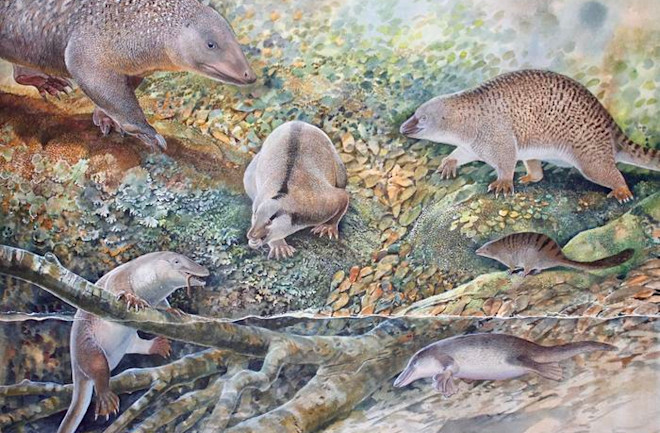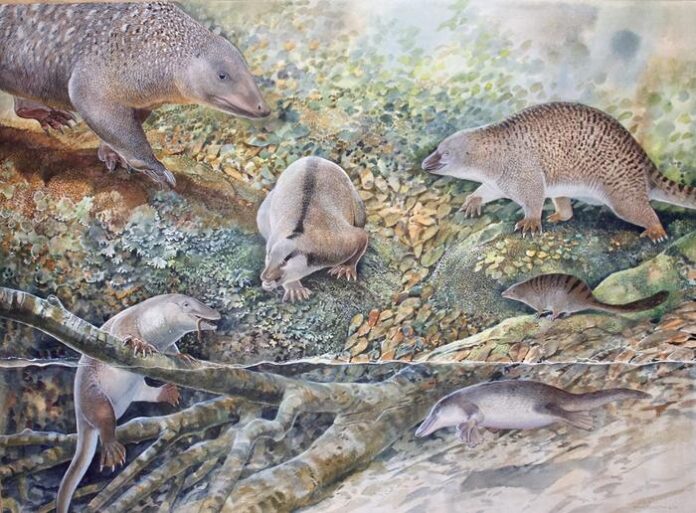
Six monotremes living in the same place at the same time, 100 million years ago at Lightning Ridge, NSw. Clockwise from lower left: Opalios splendens, a newly described species dubbed an ‘echidnapus’; Stirtodon elizabethae, the largest monotreme of the time; Kollikodon ritchiei, with hot-cross-bun shaped molars; Steropodon galmani, now known from additional opalised fossils; Parvopalus clytiei, the smallest monotreme of the time; and Dharragarra aurora, the earliest known species of platypus. (Credit: Illustration by Peter Shouten)
The skeleton looks like a duck-billed platypus, and the creature probably walked like a duck-billed platypus, but it isn’t necessarily a duck-billed platypus. It might be a newly discovered species that sits evolutionarily between an echidna and a platypus, according to a study published in Alcheringa: An Australasian Journal of Paleontology.
An Australian team of researchers analyzed three new monotreme species in New South Wales, dating back about 100 million years ago. One of them, Opalios splendens, seems like a bridge between echidna and platypus.
“Opalios splendens sits on a place in the evolutionary tree prior to the evolution of the common ancestor of the monotremes we have today,” Tim Flannery, honorary associate of the Australian Museum and a co-leader of the excavation team, said in a press release.
“Its overall anatomy is probably quite like the platypus, but with features of the jaw and snout a bit more like an echidna – you might call it an ‘echidnapus’,” said Flannery.
The Echidna and the Platypus
Both are mammals with similar anatomies, although modern echidnas have narrower jaws and snouts. And both echidnas and platypuses are considered monotremes. Monotremes lay eggs and don’t have teats. Instead, they secrete milk through pores in their bellies.
Flannery highlighted that today, echidnas have no teeth, and platypuses too are essentially toothless. The three new species, found in the opal fields of Lightning Ridge, had a variety of teeth among them. That diversity represents another look at the evolution of monotremes.
“The story of how our egg-laying mammals evolved from ‘toothy to toothless’ on the oldest monotreme, Teinolophos trusleri, which dates back to Victoria 130 million years ago,” Kris Helgen, chief scientist and director of the Australian Museum Research Institute (AMRI) and co-leader of the team, said in a press release.
“What we see at Lightning Ridge is that by 100 million years ago, some of the monotremes still have five molars but some of them are down to three,” said Helgen.
Read More: Why Do So Many Weird Animals Live in Australia?
Finding the Ancient Species
Elizabeth Smith and her daughter Clytie of the Australian Opal Centre in Lightning Ridge found the fossils. They have spent decades searching the opal fields.
Both the diversity and abundance of monotreme fossils from that site paint a picture of a very different Australian mammalian landscape — one populated with furry egg-layers.
“Today, Australia is known as a land of marsupials, but discovering these new fossils is the first indication that Australia was previously home to a diversity of monotremes,” Flannery said in a statement. “It’s like discovering a whole new civilization.”
Article Sources
Our writers at Discovermagazine.com use peer-reviewed studies and high-quality sources for our articles, and our editors review for scientific accuracy and editorial standards. Review the sources used below for this article:
Before joining Discover Magazine, Paul spent over 20 years as a science journalist, specializing in U.S. life science policy and global scientific career issues. He began his career in newspapers, but switched to scientific magazines. His work has appeared in publications including Science News, Science, Nature, and Scientific American.
Source : Discovermagazine














